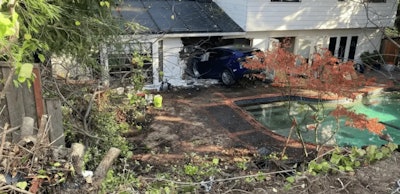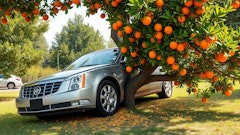
Toronto, Ontario — In this weekly electric and autonomous vehicle report, a Tesla Model X driver reportedly flew their vehicle 50 feet after hitting a curb; and GM’s Cruise makes tentative steps to begin a scaled-down comeback following lawsuits.
Houston, we have a problem
Recently, a Tesla Model X driver discovered the hard way that flying cars are still a thing of the future after losing control of their vehicle, hitting a fence and flying over a pool to crash into a house.
According to California-based news station KUTV—where the crash took place in San Mateo, California—no one was seriously injured by the crash.
The owners of the house weren’t home at the time of impact and the driver (reportedly a 70-year-old woman) was taken to the hospital but reported as fine by paramedics; her 40-year-old daughter, also in the vehicle, was not injured either.
While details about the Tesla’s speed and the exact cause of the crash aren’t available yet, reports indicate that the Model X hit a curb and this somehow caused it to ‘take to the air.’
“My sister actually got an alert from the security alarm system to let her know that someone had broken into the house,” Meredith Donato, relative of one of the home owners, told KUTV. “If my mother was in the house, she would absolutely have been drinking her tea at 7 a.m. in the kitchen.”
The impact of the crash was so loud that some residents in the neighbourhood assumed it was an earthquake.
Police have confirmed that the Tesla’s autopilot feature was not engaged when the driver lost control and added that the car travelled between 40 to 50 feet in the air before crashing into the house’s kitchen.
Cruising at a Crawl
Cruise executives are taking a measured business approach to pressure investments and calls for improved safety in an attempt to correct GM’s autonomous vehicles.
The first steps in this rebuilding plan, which includes pausing production on Cruise’s Origin robotaxi, were laid out in an internal email sent to employees by Mo Elshenawy, who was executive VP of engineering at Cruise before ascending to president following co-founder and CEO, Kyle Vogt’s resignation.
For now, this strategy includes more “realistic plans,” according to Elshenawy, with a focus on Cruise’s current robotaxi platform, the Chevy Bolt AV.
This latest email notes that while development of the Origin program will continue, the vehicle will not be produced in 2024.
While Elshenawy didn’t provide a timeline for when Cruise would restart operations, he did say the company would relaunch in just one city at first, and this marks a substantial departure from the previous multi-city launch strategy focused on earlier this year.






















